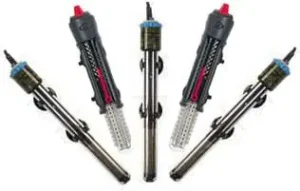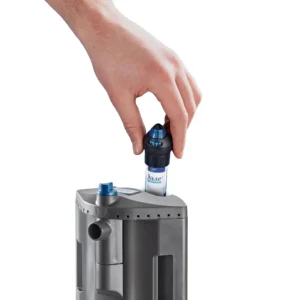Assuming you intend to keep tropical and not cold water fish in your aquarium, you’ll need a heater.
Tropical fish require the temperature of the water to be between 75-80 degrees Fahrenheit (23-27 degrees Celsius).
This will be above the usual ambient room temperature in the UK for the majority of the year.
Heaters come in a huge variety of types, sizes, etc. and picking the right one can be bewildering. So let’s have a look at the different aquarium heaters available so you can make the right choice.

Table of Contents
Heater Types
Submersible Heaters
Are fully waterproof and can be completely submerged in your aquarium. This means you have maximum flexibility on where to place the heater in your tank.
These are by far the most common type of heater and are usually the type supplied with most new aquarium systems.
Filter Heaters
Are simply submersible aquarium heaters that are placed inside your filter, be it an in-tank or external filter or sump.
If your filter caters for an internal heater then we’d recommend that’s where you place it.
Immersion Heaters
Are no longer very common and they differ from submersible heaters in that they can NOT be fully submerged.
Obviously, this could be a serious problem if you accidentally drop one in your fish tank. As such, you should stay clear of these types of aquarium heaters.
Substrate Heaters
Likewise, no longer common as this type of heater works with an under gravel filtration system which is now not much used in the hobby.
The main problem with this type of filtration system is the difficulty of access for any ongoing maintenance and cleaning.
Heater Design

Glass Heaters
Are the most common and cheapest aquarium heater you can buy and will almost certainly be the type you have if you purchased an all-in-one aquarium system.
They work well for most smaller-sized tanks but can be easily broken if handled incorrectly.
Larger aggressive fish or startled fish have also been known to inadvertently shatter glass heaters on occasion so bear that in mind.
Glass Heaters with a Guard
As a result of glass heaters’ tendency to break easily, many now come enclosed in a moulded plastic guard either partially or completely encasing the heater.
This will certainly protect the heater from over-exuberant fish but you should still handle them carefully and not drop them.
Whether with a guard on not, glass heaters have a temperature setting dial built in so you can set your desired temperature.
The dial is usually at the top but some heaters have one on the side.
The heater monitors the water temperature and switches off once it has reached the correct temperature and on again when the water temperature drops.
Titanium Heaters
Are not only virtually indestructible but are better at conducting heat than glass heaters making them more efficient and cheaper to run.
However, they tend to be more expensive to buy and require a separate Heater Controller to regulate their temperature.
Most heaters will work in either a freshwater of marine aquarium but we’d recommend that you check before you buy that this is the case. Saltwater is far more corrosive than freshwater so care should be taken.
Heater Placement

If your filter has a place to install your heater, then this will invariably be the best place to install it.
Circulation through your filter and around a heater contained within it, will ensure a good even heat distribution throughout your aquarium.
Otherwise, if you are installing your heater in the tank itself place it in an area of good circulation.
This could be close to your filter outlet or in a corner where the flow is strongest.
Avoid placing the heater in front of your filter inlet as it could interrupt the flow and possibly even overheat the good bacteria in your filter.
Placing the heater horizontally or diagonally on the back of the tank and lower down can also aid heat distribution as the heat rises from the bottom to the top of the aquarium.
Heater Size
Remember, tropical fish require the temperature of the water to be between 75-80 degrees Fahrenheit (23-27 degrees Celsius).
The bigger the aquarium, the greater the wattage of heater required and in larger tanks more than one heater is recommended. See the table below for a general guide:-
| Tank Size | Heater Size |
| 25 Litre | 25W |
| 50L | 50W |
| 75L | 75W |
| 100L | 100W |
| 150L | 150W |
| 200L | 200W or two 150W |
| 250L | 250W or two 200W |
| 300L | 300W or two 250W |
For larger tanks > 200 litres, we recommend using two, slightly smaller wattage heaters together.
This provides a fall back in case one heater fails and will keep your tank temperature high enough until you can get a replacement.
Two heaters should not use more power as they will each be on for less time.
Heater Safety
Obviously, electricity and water do not mix well so we need to take some precautions:-
- Ensure that there is a drip loop between the heater and wall outlet as shown
- Turn off all electrical when conducting maintenance on your aquarium
- Replace your heater if it shows any obvious signs of wear and tear
- Replace your heater for a new one every 1 – 2 years
- Use a heater controller
Heater Controllers
A heater controller is a separate device that both controls when and how often your heater is turned on but also independently monitors the water temperature.
We look further into how and why you should use a heater controller in this article, Using a Temperature Controller On Your Aquarium and we review the best here, Best Aquarium Temperature Controllers.
Recommended Heaters
Take a look at our guide, Best Rated Aquarium Heaters to help you choose the right heater for your aquarium.
Heater for Your Aquarium FAQs
What size heater do I need for my aquarium? – An easy rule of thumb would be 1W for every litre of water volume. So a 25-litre aquarium requires a 25W heater, a 50-litre aquarium requires a 50W heater and so on.
Larger aquariums, above 250 litres, may require 2 heaters.
Are aquarium heaters expensive to run? – Not as much as you might think. They are relatively low wattage and, provided they have an inbuilt thermostat, won’t be on 24 / 7.
See our article, Fish Tank Power Consumption for more information.
Can I put 2 heaters in my aquarium? – Certainly, for larger aquariums, above 250 litres, you should use 2 heaters.
This ensures you are not overworking a single heater and provides backup in case one heater fails.
